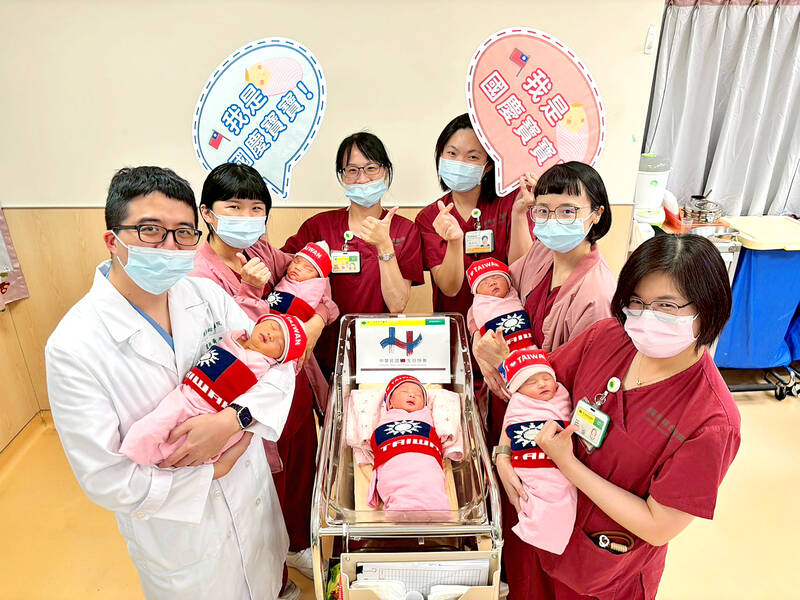Hospitals across the nation celebrated the birth of babies born yesterday, Taiwan’s National Day.
Among them was a baby born at Shin Kong Wu Ho-Su Memorial Hospital in Taipei to a woman surnamed Weng (翁), who is in her 30s.
“I did not pick the date on purpose, as babies born on this day do not come with a lifetime of perks,” Weng said with a laugh.

Photo courtesy of the Hsinchu City Government
As of noon yesterday, Linkou Chang Gung Memorial Hospital in New Taipei City had reported eight “National Day babies,” while Taipei Chang Gung Memorial Hospital recorded two. Mackay Memorial Hospital and Cathay General Hospital each reported five births.
Shin Kong hospital said it had already welcomed four babies and two more were expected later yesterday.
Lee Wei-chun (李維鈞), director of Shin Kong’s high-risk pregnancy center, discouraged parents from scheduling caesarean deliveries just to deliver on an auspicious date.
Staffing levels are also typically lower during holidays and medical resources should be reserved for those in genuine need, Lee said.
Da Chien General Hospital in Miaoli County said it welcomed five newborns yesterday, including two pairs of twin boys delivered by caesarean section.
The mother of one set of twins, a 34-year-old woman surnamed Chen (陳), had gestational diabetes, the hospital said.
Her pregnancy reached 37 weeks yesterday, and her doctors scheduled the caesarean section for that day.

Taiwanese scientists have engineered plants that can capture about 50 percent more carbon dioxide and produce more than twice as many seeds as unmodified plants, a breakthrough they hope could one day help mitigate global warming and grow more food staples such as rice. If applied to major food crops, the new system could cut carbon emissions and raise yields “without additional equipment or labor costs,” Academia Sinica researcher and lead author the study Lu Kuan-jen (呂冠箴) said. Academia Sinica president James Liao (廖俊智) said that as humans emit 9.6 billion tonnes of carbon dioxide compared with the 220 billion tonnes absorbed

The Taipei Mass Rapid Transit (MRT) Wanda-Zhonghe Line is 81.7 percent complete, with public opening targeted for the end of 2027, New Taipei City Mayor Hou You-yi (侯友宜) said today. Surrounding roads are to be open to the public by the end of next year, Hou said during an inspection of construction progress. The 9.5km line, featuring nine underground stations and one depot, is expected to connect Chiang Kai-shek Memorial Hall Station to Chukuang Station in New Taipei City’s Jhonghe District (中和). All 18 tunnels for the line are complete, while the main structures of the stations and depot are mostly finished, he

Taipei is to implement widespread road closures around Taipei 101 on Friday to make way for large crowds during the Double Ten National Day celebration, the Taipei Department of Transportation said. A four-minute fireworks display is to be launched from the skyscraper, along with a performance by 500 drones flying in formation above the nearby Nanshan A21 site, starting at 10pm. Vehicle restrictions would occur in phases, they said. From 5pm to 9pm, inner lanes of Songshou Road between Taipei City Hall and Taipei 101 are to be closed, with only the outer lanes remaining open. Between 9pm and 9:40pm, the section is

China’s plan to deploy a new hypersonic ballistic missile at a Chinese People’s Liberation Army Rocket Force (PLARF) base near Taiwan likely targets US airbases and ships in the western Pacific, but it would also present new threats to Taiwan, defense experts said. The New York Times — citing a US Department of Defense report from last year on China’s military power — on Monday reported in an article titled “The missiles threatening Taiwan” that China has stockpiled 3,500 missiles, 1.5 times more than four years earlier. Although it is unclear how many of those missiles were targeting Taiwan, the newspaper reported